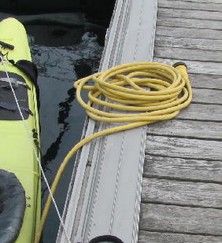PutterLaz
Member
- Messages
- 6
- Reaction score
- 1
Follow along with the video below to see how to install our site as a web app on your home screen.
Note: This feature may not be available in some browsers.


Can you explain what would cause an "anode" issue?You may have an anode or electrical issue with your boat if you have pits like that, is it still under warranty? The pics are too small to see details real well.
That youtube powerpoint, although lengthy, is really an eye opener. If you dock ANYWHERE where power is nearby you should invest the time to watch this!Hot Docks and electric shock drowning
In 1999, 8 year old Lucas Ritz was electrocuted while swimming in a fresh water marina. The coroner wrote it off as a drowning. Lucas' father didn't believe it and performed his own investigation. Kevin spent years educating himself and subsequent studies by Kevin and Captain (ret'd) David Rifkin USN found more than 200 reported "drowning" fatalities in fresh water marinas were actually electrocutions.
This phenomenon is now known as "electric shock drowning" and is still ignored by most marinas. Essentially what happened was that a DC conductor melted against an AC conductor and fed AC current down the shaft into the water. I implore you to take the time to watch this youtube powerpoint by Kevin Ritz who explains how faulty boat wiring caused his sons death. Captain David Rifkin a consultant to USCG, BoatUS® and ABYC® has much more information on this and other marine electrical issues on his website.
AC current can get into the water through faulty onboard wiring as in the Ritz example, faulty shorepower supply or simply because one of Darwins rejects unplugs his boat and leaves a live cord lying on the dock. All photos in the three columns below were taken on the docks around my own boat. at Port Credit Yacht Club. I've posted only a few of the over 50 photos I took within just a few minutes. Proof that common sense is anything but. common.
In my surveys I write more recommendations on electrical issues than any other area. When I point out an unsafe battery installation or explain why electrical equipment in a gasoline engine compartment must be ignition protected, most people seem to understand, they rarely actually fix it but I've done what I can. For some strange reason otherwise seemingly intelligent people do not grasp the importance of simple things like polarity indicators , G.F.C.I.'s or proper AC ground systems.
For more information on boats electrical AC and DC systems including battery installations and how to inspect them, I recommend you take a look at Marine Survey 101
Please do not take this stuff lightly.

Society of Accredited Marine Surveyors
I was parked in a cannel off Indian River MI right next to Indian River Marina, boat most of the time on Burt Lake.Pretty sure corrosion isn't covered by warranty. Where do you boat?
Pittsburg, thank you for this valuable information. This is my second boat and makes me wonder why the marina does not disclose this info when you purchase a boat? Thanks again.Hot Docks and electric shock drowning
In 1999, 8 year old Lucas Ritz was electrocuted while swimming in a fresh water marina. The coroner wrote it off as a drowning. Lucas' father didn't believe it and performed his own investigation. Kevin spent years educating himself and subsequent studies by Kevin and Captain (ret'd) David Rifkin USN found more than 200 reported "drowning" fatalities in fresh water marinas were actually electrocutions.
This phenomenon is now known as "electric shock drowning" and is still ignored by most marinas. Essentially what happened was that a DC conductor melted against an AC conductor and fed AC current down the shaft into the water. I implore you to take the time to watch this youtube powerpoint by Kevin Ritz who explains how faulty boat wiring caused his sons death. Captain David Rifkin a consultant to USCG, BoatUS® and ABYC® has much more information on this and other marine electrical issues on his website.
AC current can get into the water through faulty onboard wiring as in the Ritz example, faulty shorepower supply or simply because one of Darwins rejects unplugs his boat and leaves a live cord lying on the dock. All photos in the three columns below were taken on the docks around my own boat. at Port Credit Yacht Club. I've posted only a few of the over 50 photos I took within just a few minutes. Proof that common sense is anything but. common.
In my surveys I write more recommendations on electrical issues than any other area. When I point out an unsafe battery installation or explain why electrical equipment in a gasoline engine compartment must be ignition protected, most people seem to understand, they rarely actually fix it but I've done what I can. For some strange reason otherwise seemingly intelligent people do not grasp the importance of simple things like polarity indicators , G.F.C.I.'s or proper AC ground systems.
For more information on boats electrical AC and DC systems including battery installations and how to inspect them, I recommend you take a look at Marine Survey 101
Please do not take this stuff lightly.

Society of Accredited Marine Surveyors
Unfortunately we have not been able to determine the source. If I have any more info I will post it. Thanks for response.Putterlaz, what was the outcome of the source of the current? Did an electrician come out?